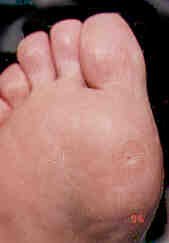Plantar
Keratosis
Synopsis
Plantar Keratosis is a
discrete callus, usually about 1 centimeter in diameter, directly under a
metatarsal head, under the ball of your foot. This is caused by a "dropped
metatarsal" which causes the metatarsal head to lie at a lower level than
the surrounding metatarsals and protrude from the bottom of the foot. This
results in more pressure being applied in this area and causes a thick callus to
form. Patients usually complain of pain directly under the affected metatarsal
at the location of the callus, made worse by prolonged periods of standing or
activity. This pain is described initially as an ache, but can get more painful
with continued thickening of the callus.
This problem can usually be diagnosed by your doctor with a physical examination
of your foot. A plantar wart, a skin growth caused by a virus infection and not
by pressure, can sometimes mimic this problem, but these two conditions have a
different appearance and can usually be differentiated by exam. Often the
affected metatarsal head can be felt to be lower in position than the
surrounding metatarsals. Sometimes an x-ray may be taken of the front part of
your foot, which will show the relative positions of the metatarsal heads.
|

|
|
This picture
illustrates an IPK after reduction of the surface layer of callus. Note
the small "core" (nucleation) at the center. Direct
pressure on this area is very painful. Further reduction involved enucleation
with a small sharp instrument. This is not usually painful. |
A "dropped metatarsal" can either be a congenital structural
abnormality, a result of a metatarsal fracture that healed in a displaced
position, or a structural change that may have occurred over time. A
contributing factor may be a hammertoe that contracts and puts retrograde
downward pressure on the metatarsal head. This causes the metatarsal head to be
driven into the ground and increases the pressure and friction on the underlying
callus.
Treatment and
Prevention
The callus contributes to the pain by causing excessive body weight to be borne
by the injured underlying area. You may try smoothing it down with a pumice
stone or emery board when you get out of the bathtub or shower and your skin is
soft and wet. Switch to athletic shoes or shoes with a soft sole and good
forefoot cushioning. Also of benefit may be insoles to add more cushioning to
the bottom of your foot, if your shoes have enough extra room to accommodate
them.
Depending on your overall health and circulation status, your doctor may
recommend periodic trimming of the callus and fit you with a insole or custom
arch support that provides padding around the callus and prevents or decreases
direct pressure being put on the callus when you walk. Your doctor will discuss
other options that may include surgically realigning the affected lower
metatarsal head, so it lies at a higher level, more in line with the other
metatarsals. Correction of an associated hammertoe will also prevent the
backwards-downward pressure that may be adding to this problem. Surgery will be
designed to actually correct the structural problem itself that is causing the
callus and pain.
By following the treatment plan your doctor recommends, you can minimize your
future problems with this deformity.
